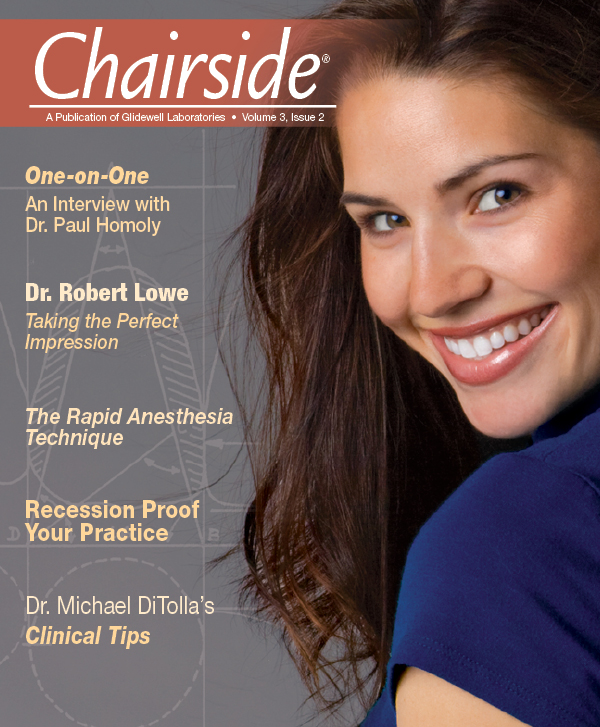Seven Strategies to Recession Proof Your Practice

The formal definition of a recession is two consecutive quarters of decline in the GNP (gross national product). According to this definition we are not officially in a recession; however, depending on where you are located in the country, it’s likely your local economy is sputtering a bit. As a practice advisor, I have weathered three recessions in my career and helped my clients navigate the challenges of a soft economy. This article will present seven specific strategies to recession proof your practice to help you not only survive, but actually thrive in the current conditions.
Before I present these seven strategies, I’d like to inform you of a new development in my professional life that makes this article even more relevant. In May of 2007 I purchased a dental practice in partnership with Dr. Paul Nielson. I purchased this practice to serve as a learning and teaching lab for my clients. Dr. Nielson and I are in the process of developing and evolving this practice into our “ideal” practice. Each day I am living and breathing the very challenges that you are facing. As a result, I have newfound empathy for you doctors and your team members! These seven strategies are precisely the things that Dr. Nielson and I are doing now to strengthen our practice in the soft economy.
One of the things that we are doing in our own practice to increase value is to provide our patients with a written warranty for our treatment.
Provide increased value by offering a warranty
Regardless of a person’s economic standing, people appreciate good value. Good value does not necessarily mean a low price. If you pay a low price for a product or service and the product or service does not last, then there is little value. One of the things that we are doing in our own practice to increase value is to provide our patients with a written warranty for our treatment. The warranty tells our patients that we stand behind our treatment and provides us with another means of overcoming fee objections.
One requirement of our warranty is that the patient must visit our office for their recommended hygiene visits in order for the warranty to stay in effect. If they do not keep their recommended hygiene visit schedule, then the warranty is voided. This gives the patient added motivation to keep on a regular hygiene schedule, which serves us and them! If you would like to receive a copy of our written warranty to serve as a guide for your own, simply email my office manager at mari@garytakacs.com and she will forward you our written warranty.
Initiate a “gift card” referral program
Years ago someone came up with the idea of the “Be a Friend to a Friend” program. The concept behind this program was to encourage your patients to refer others to your practice by offering them a credit in your office (often $25–30) as a referral incentive. I always loved the idea, but I didn’t like the reward of discounting your services. So, I contacted my friend, Brad Stewart, the founder of Sum Media (sum-media.com) and one of the brightest marketing minds I know, to create a 21st century variation of this referral program. As a result, Brad and his team developed a gift card referral program.
With this gift card referral program, we offer our patients a choice of six different gift cards to choose from when they refer someone to our office. We support this program with high quality countertop signs and small take-one brochures in our office. The collateral material leads with the headline, “Isn’t it Great to Share the Things You Love…and that Includes Your Dentist.” The graphics and production quality of the collateral material are very high quality and represent your office well. This gift card program gives you and your team members a fun and easy way to ask for referrals, and patients really like getting the gift cards.
The gift card program is responsible for approximately two-thirds of the new patients we see each month, and the cost of generating these new patients is very low compared to other forms of marketing. An added benefit is that these patients who are referred to us by loyal existing patients tend to have a higher degree of trust and confidence in us because they were directed to us by a happy existing patient.
Eliminate negative reading material in your office
I was watching the TV show “Meet the Press” a couple of months ago, and the host, the late Tim Russert, was interviewing a banker on the state of the economy. Tim asked her, “Are we currently in a recession, and if not, do you see one coming?” The banker answered, “We are not currently in a recession, but if you keep talking about it you might just talk us into one!” This comment is so appropriate!
If your office subscribes to any business or current affairs magazines, get rid of them! These magazines are filled with gloom and doom bad news these days. No need to feed the gloom and doom. Let me present another reason why magazines do not belong in your office.
A couple of years ago a client of mine had a fairly simple consultation with a new patient that resulted in the doctor presenting a modest treatment plan that totaled $895. This treatment was not urgent and the patient was in no pain. The patient said that he would need to think about it, which is a long-winded (and polite) way of saying no. Because this was the last patient of the day, the doctor walked him out. On his way back through the reception room, the doctor noticed a magazine open to a full-page ad promoting a vacation to Hawaii for — you guessed it — $895. I am convinced this patient decided (perhaps even subconsciously) to go to Hawaii instead of accept the recommended treatment!
Because the content of most magazines is more than 70% advertising, consider eliminating all magazines and replacing them with coffee table type books that feature the interests of doctor and team members.
Outside financing programs such as CareCredit® allow you to offer affordable payment options to your patients by outsourcing financing to the experts.
Value-price whitening
If you have been reading my past articles in Chairside®, you know I am a big fan of whitening because whitening is a gateway service that leads patients to greater interest in their teeth. Whitening is also a great feel good service to offer in a soft economy. Patients want to look and feel their best, and treating themselves to an inexpensive service like whitening can be an uplifting experience for them.
To encourage more whitening, I suggest you value-price this service. Consider charging $195 for take-home whitening and $395 for chairside whitening such as Zoom!® You will find that there is still a small profit even with these low fees, but more importantly you will find that more patients will accept whitening at these lower fees. It is not unusual for these very same patients to want other services after they whiten their teeth. Think of whitening as sowing the seeds of your future cosmetic and restorative cases.
Offer outside financing and get good at promoting affordable payment options
In a soft economy more patients will need some payment flexibility to accept ideal treatment. Outside financing programs such as CareCredit® (carecredit.com) allow you to offer affordable payment options to your patients by outsourcing financing to the experts. You get paid up front and the patient gets the payment flexibility that they need or want. If you do not have one of these outside financing programs in your office, get one.
Many offices already have an outside financing program in place, but they really are not using it to its full potential. Hence the second part of this strategy, namely: “Get good at promoting affordable payment options.” Encourage your team members to really listen to patients’ concerns and, if the concerns are financial, to be quick to suggest that your office has some great payment options to make the care affordable. Consider asking your financial coordinator to present training at your next meeting to discuss how your office can get really good at promoting affordable payment options. This leads me to my next recession proofing strategy.
Invest in team training
Now is the time to invest in team member training so that the entire office operates as a high-performance team. Many dentists and team members are guilty of spending so much time working in their practice that they never have time to work on their practice. Now is the time to break this habit and devote some time to working on your practice so that you can be as efficient as possible and consistently deliver a high level of patient service. I’d recommend that you devote a one-hour team meeting per week to work on your practice.
There are many resources that you could introduce to your team members during these meetings. Consider DVDs or videos as very cost-effective content for some meetings. Dr. Michael DiTolla has created some excellent clinical DVDs that you have read about in Chairside. Dr. Gordon Christensen has a great library of videos covering a wide variety of topics, and National Dental Network is another excellent source of high quality material. DVDs and videos are inexpensive and will bring another voice to your meetings.
One last note on team training is that I recommend you periodically rotate the leadership of this meeting to your team members. The best way to learn something is to teach it and leading a short session will provide valuable experience for your team members.
Be positive
I have saved the most important strategy for last! It may seem self evident, but the best possible strategy to recession proof your practice is for you and your team members to be a positive, uplifting force in your patient’s lives. A soft economy and the constant barrage of negative news have the effect of wearing people down. Visits to your office need to be a positive experience that helps your patients feel better about themselves.
If you have not read the all-time classic book titled “How to Win Friends and Influence People” by Dale Carnegie, then read this incredible book immediately! If you have read it, go back and re-read it and make a commitment to apply the wisdom in its pages. This timeless classic offers an amazing blueprint to follow to be a positive influence on people.
Perhaps the main reason why patients do not accept ideal treatment is that they do not think they deserve it. Make it your goal to help every patient you see feel better about themselves. It could be something as simple as making it a point to remember their name, making evening “We care” telephone calls to any patient who had an injection that day, or writing two or three personal note cards to patients you saw that day. These may seem like little things, but they have a very positive compounding effect on the relationship you have with your patients.
Here is a summary of seven things you can do to recession proof your practice:
- Provide increased value by offering a warranty
- Initiate a “gift card” referral program
- Eliminate negative reading material in your office
- Value-price whitening
- Offer outside financing and get good at presenting affordable payment options
- Invest in team training
- Be positive
These strategies will help you thrive in these challenging economic times, as well as help you build a foundation that will serve you well in any economic climate!
Author credit: For more than 25 years, Gary has coached dental offices to achieve their full potential. To learn how his coaching services can help you develop your ideal practice, feel welcome to email him at gary@garytakacs.com. Gary is also available to speak to your dental association or study club. Visit garytakacs.com to learn more.
CareCredit is a registered trademark of GE Money Company (Norwalk, Conn.). Zoom! is a registered trademark of Discus Dental (Culver City, Calif.).



